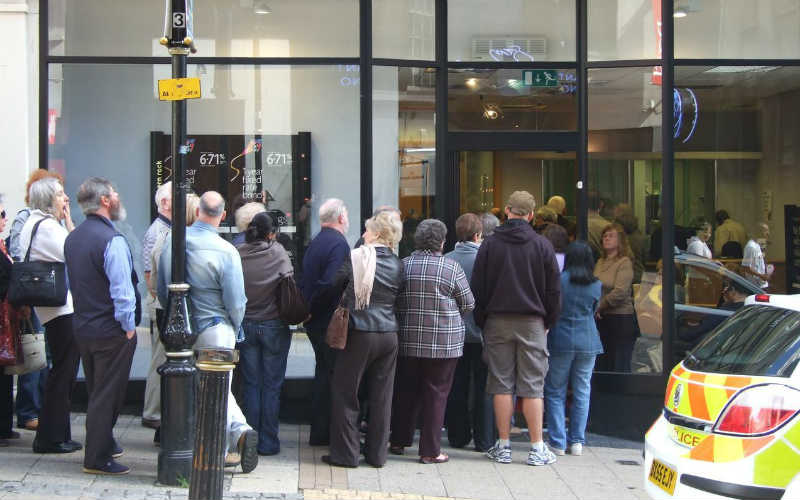You may have wondered about this, particularly in the aftermath of Silicon Valley Bank’s collapse earlier this month. This is the second largest bank failure in the history of the United States, and has prompted fears of a ripple effect throughout the banking world.
Investors across the globe are increasingly nervous about the stability of the banking sector, and many international institutions have taken hits. Swiss Investment Bank Credit Suisse saw its share price drop to a record low 1.68 Swiss francs, with trading intermittently suspended as the stock fell. Other European banks like Deutsche Bank (down 6.4%) and Barclays in the UK (down 6.5%) are feeling increasing pressure.
In Australia, the Council of Financial Regulators (CFR), the coordinating body for the RBA, APRA and the Treasury, was quick to assure Australians that our banking system remains ‘strongly capitalised and highly liquid,’ but concern will no doubt remain.
So in the highly unlikely event that your bank calls it a day, what happens to you and your money? Let’s try to unpack this complicated scenario.
Advertisement
Need somewhere to store cash and earn interest? The table below features savings accounts with some of the highest interest rates on the market.

- Bonus variable rate for the first 4 months on balances up to $250k and high variable ongoing rates.
- No fees and no monthly requirements to earn interest.
- Easily open an account online in 3 minutes.
How banks build their money
To understand how banks go bust, it's helpful to think about exactly how retail banking works. Banks pay consumers interest to deposit money (in savings accounts, term deposits, etc.), which banks then use to issue loans, naturally charging significantly higher interest rates.
Banks have many different sources of revenue - see below - but loans make up a big chunk of a bank’s interest-earning assets. Other ways include wholesale funding such as securitisation, and occasionally some help from the Reserve Bank.
One of the many shocking discoveries of adulthood is that banks only have a fraction of the amount deposited with them on hand at any one time. As a child, you might have pictured huge vaults filled to the brim with everyone’s money, but in fact, when you deposit an amount with a bank, they will generally only keep about 10% (this amount is mandated by the reserve ratio) and loan out the rest. The loans are assets that the bank earns revenue from, while deposits are a liability that they owe customers. The most common way a bank fails is when their assets are less than their liabilities, and they are unable to pay depositors and creditors.
There are two main ways this could happen. Both are unlikely, but as we’ve just witnessed in the US, not impossible.
Firstly, a bank's assets could diminish to become less than their liabilities. Suppose a huge number of a banks' borrowers were suddenly unable to pay their loans back anymore. The bank could then be forced to write off those loans - which it would be reluctant to do because a bank’s loan portfolio is typically its primary asset. If enough loans were written off, the bank may not be able to generate enough revenue to meet its liabilities, and would need to find money from elsewhere, or risk going under.
The other common way a bank could go under is what’s called a bank run. This is the scenario your adolescent brain leapt to when you found out they don’t have everyone’s money on hand: What happens if everyone withdraws their money at once? Banks, and by extension the entire financial system, rely on this not happening. While they are rare (the last in Australia was Queensland Permanent Building Society which suffered a bank run and closed its doors in 1977), it can occur when people are scared that the bank is about to collapse. People rush to get all their money out beforehand, which ironically contributes to the bank going under when it does happen.
What happened to Silicon Valley Bank was a little bit of both. Many of the assets it held were impacted by increases to the United States' cash rate, forcing it to sell some of these, losing $1.8 billion in the process. Word got out among customers who panicked, prompting a surge in withdrawals. Within 48 hours, enough people had withdrawn their money that the bank was forced to close their doors.
What happens to your savings if your bank collapses?
If you’re getting nervous about the money in your own savings accounts, you can relax. Should your bank collapse, the government will step in to make you whole (to a point).
The Australian Government guarantees customer deposits up to $250,000 with Authorised Deposit-Taking Institutions (ADIs) under the Financial Claims Scheme (FCS).
The FCS was introduced after Global Financial Crisis (GFC) to boost confidence in the banking system and the security of people’s money.
For brief point, the FCS covered up to $1 million in deposits, but was later reduced to $250,000.
At the time of writing, there have been no claims under the FCS, so it remains to be seen how deposits are returned to customers in real-world scenarios, and how long this claims process could take.
APRA Financial Claims Scheme Explained
Under the FCS, if you have up to $250,000 in your savings account, you will receive all of that money back in the event that the bank collapses (provided that your bank is on this list of ADIs). However, if you have more than $250,000 in deposits with the one bank you won’t be guaranteed to get it all back.
For example, if you have $460,000 in a savings account, you are guaranteed to get $250,000 back but risk losing the remaining $210,000.
The scheme is capped at one person per financial institution, but you can get the guarantee with as many financial institutions as you like. So you could put $250,000 with Bank A and the remaining $210,000 with Bank B and be 100% guaranteed for both amounts.
It’s worth noting that multiple banks may be under the same ADI. So if you have $250,000 with Bank A and $250,000 with Bank B but they’re both under the same ADI, then you will only be guaranteed for the first $250,000 - not $500,000.
The $250,000 guarantee also applies to each holder if the account is jointly owned. If you and your partner share a joint account with $500,000 in it, both of you are individually guaranteed up to $250,000.
The government guarantee applies to all customer deposits with a licensed bank, so that includes funds in savings accounts, transaction accounts, term deposits and offset accounts.
The FCS also applies to credit unions and building societies.
If you’re still unsure your money will be covered, the Australian Prudential Regulation Authority (APRA) has a handy deposit checker on its website.
Depositor preference
Beyond the FCS that protects amounts up to the $250,000 cap, there’s another level of protection that covers all deposits (not just amounts under the $250k cap) called ‘depositor preference’.
According to the RBA: “Deposits above the cap in Australian ADIs also benefit from depositor preference. This means that Australian depositors have a priority claim on the assets of a failed ADI ahead of other unsecured creditors, after the Government has been reimbursed for any amounts paid under, and expenses incurred in relation to, the FCS”.
Essentially, this means that if an Australian bank collapses, APRA (on behalf of the Government) gets first preference over the bank’s assets to recover amounts paid out to depositors under the FCS (the $250,000 guarantee) and other expenses incurred in operating the FCS.
After APRA, the failed bank’s remaining assets in Australia must then be used to repay any deposits in Australia above the $250,000 cap before they can be used to repay other unsecured creditors.

Pictured: A bank run in the UK in 2007. Image by Lee Jordan via Flickr.
What happens to your mortgage if your bank or lender goes bust?
Sadly, you don’t get a free pass on your mortgage or a free house (but we can dream).
If your lender went bust, the most likely outcome is that your mortgage would get sold to another lender. The terms of your mortgage contract are unlikely to change because only your repayments are being given to another financial institution. Essentially, you keep calm and carry on making your mortgage repayments.
Once your mortgage has been sold to another lender, the interest rate could move up or down depending on how the new lender sets their rates.
If your lender were to go bankrupt, they can’t 'call up’ your mortgage - meaning they can’t ask you to pay the remainder of your loan in full.
What happens to the money in your redraw facility?
The government guarantee does not cover redraw facilities - whether your lender is an ADI or not. So it doesn’t really matter if you’re with a big four bank or an online non-bank lender - the government guarantee does not apply to redraw facilities, full stop.
However, if your lender were to go bust, any extra mortgage repayments you have put into the redraw facility would be deducted from the amount you owe the lender. So, your outstanding loan balance would effectively be reduced and your net position would not be impacted.
On the other hand, mortgage offset accounts are covered under the $250,000 government guarantee.
Don’t know the difference between a mortgage offset and a redraw facility? While they are similar, a mortgage offset account is pretty much like a transaction account - the money in which is ‘offset’ against the home loan debt, reducing the interest costs. Meanwhile, a redraw facility is a home loan feature that allows you to redraw extra repayments you’ve made on your home loan.
Are non-bank lenders and neobanks safe?
Contrary to what some people may think, non-bank lenders and neobanks are generally just as safe as any of the major banks because all are bound by strict regulations.
The newcomer to the banking block, neobanks have to obtain a full ADI license from APRA before accepting money from customers. So stashing your money into a savings account offered by a neobank is no riskier than depositing your money in a savings account with a big four bank.
While non-bank lenders may not be ADIs, this doesn’t mean these institutions are not safe to borrow from. Non-bank lenders are still governed by the Australian Securities and Investments Commission (ASIC) and bound by the National Consumer Credit Protection Act (NCCP) and Australian consumer law.
Because they have lent you money, you have their money and assuming you have a standard mortgage, they cannot ask you to pay up the rest of your loan if they went bankrupt. Just like a bank, a non-bank lender can only ask you to continue making your normal mortgage repayments.
Some people claim that because non-bank lenders are smaller, they’re more vulnerable than bigger banks during unstable economic times and would be more likely to raise interest rates. Recent history suggests this is not the case, with many non-bank lenders currently offering far more competitive interest rates than the bigger banks, and possessing market capitalisations as big as some banks with household names.
In Australia, all legitimate banks and lenders must hold an Australian Credit License (ACL) from ASIC or an Australian Financial Services License (AFSL). Banks and lenders (and finance websites like this one) must display the numbers of these ACL or AFSL licences (it’s usually found at the very bottom of a website). If you scroll down to the bottom of this website, for example, you’ll see Savings.com.au’s AFSL and ACL number:

If you’re unsure the company you’re dealing with is legitimate or not, MoneySmart has compiled a list of unlicensed companies that should be avoided.
Xinja - the latest example of an Australian bank 'collapse'?
Xinja was a neobank and was granted a full banking licence in 2019. In 2020 it had one of the highest savings account interest rates in the market. It quickly ran up the flagpole in terms of customer deposits, reaching $200 million in a matter of months.
And that right there spelled problems. It did not have any sort of loan product charging interest to compensate, so the bank was burning cash hand-over-fist in interest-paid on customer deposits.
Not even a mysterious $400 million injection from Dubai-based 'World Investments' could save the faltering neobank.
In October 2020, it cut its savings account rate; in November it cut its maximum interest rate deposit limit by two thirds; and by December it announced it would return all customer deposits and give up its banking licence.
The case of Xinja was not technically a bank failure, because it returned all deposits and APRA did not need to intervene with its Financial Claims Scheme.
However, the disappearance of a plucky neobank was noticed in the wider banking landscape; APRA chairman Wayne Byres called it a 'successful failure', according to AFR reports.
APRA has since made it more onerous to obtain a banking licence, with would-be banks required to prove sustainability rather than short-term profitability.
Savings.com.au’s two cents
While it’s highly unlikely that a bank or lender will go bankrupt in Australia, the Silicon Valley Bank situation shows how important it is to know what would happen if one did.
The headline is that there’s no need to panic. Your deposits would be protected under the government guarantee up to a limit of $250,000 and you would hopefully receive that money back almost instantly.
If you have more than $250,000 stashed away, it may be wise to spread out that money across multiple banks so that all your hard-earned savings will be protected - just check they are not covered by the same ADI otherwise your efforts will be null and void.
Those with a mortgage don’t need to worry either as the loan would likely be sold to another lender, so you would carry on making your mortgage repayments as usual. You wouldn’t lose your house, and your lender can’t ask you to pay the remainder of your loan.
Article first published 18 March 2020 by Emma Duffy, last updated 16th March 2023 by Harry O'Sullivan
First published on March 2022
Photo by Andrea Piacquadio from Pexels







